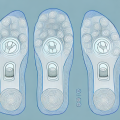Prostate health is essential for men, and it is something that should not be taken lightly. The prostate gland is a small gland that wraps around the urethra, the tube that carries urine out of the body. It is an essential part of the male reproductive system and helps produce semen, which helps transport sperm. Unfortunately, the prostate gland is also susceptible to several medical issues, causing severe discomfort and inconvenience for those affected.
Understanding Prostate Health and the Benefits of Massage
One of the most common medical issues associated with the prostate gland is BPH, or benign prostatic hyperplasia. This is a non-cancerous condition which causes the prostate gland to enlarge, pressing against the urethra and causing difficulty urinating. Other medical issues include prostatitis, an inflammation of the prostate gland, prostate cancer, and more.
Luckily, there are several methods to help alleviate symptoms associated with prostate health issues. One of these methods is through deep tissue massage, which can provide numerous benefits for prostate health. Deep tissue massage, when performed correctly, is a powerful technique that uses deep pressure to target tight and sore muscles.
Studies have shown that regular prostate massage can also help improve prostate health. This is because prostate massage can help increase blood flow to the prostate gland, which can help reduce inflammation and promote healing. Additionally, prostate massage can help flush out any stagnant fluids in the prostate gland, which can help reduce the risk of developing infections or other medical issues.
What is a Deep Tissue Massager and How Does it Work for Prostate Health?
A deep tissue massager is an electronic device that uses vibrations, heat, and pressure to penetrate deep into the muscles and tissues. It targets knots and tight muscles, helping to increase blood flow and promote healing. Deep tissue massagers work by applying pressure to specific points in the body, releasing tension and inducing relaxation.
For those experiencing prostate health issues, deep tissue massage can help alleviate symptoms by targeting the pelvic area. The prostate gland is located in the pelvic area, and massage can help improve circulation, reduce inflammation, and promote relaxation, which can all help alleviate symptoms associated with prostate health issues.
It is important to note that while deep tissue massage can be beneficial for prostate health, it should not be used as a substitute for medical treatment. It is always recommended to consult with a healthcare professional before using any type of massage therapy for prostate health issues. Additionally, it is important to use the deep tissue massager properly and follow the manufacturer’s instructions to avoid any potential injury or discomfort.
The Science Behind Deep Tissue Massage for Prostate Health
Deep tissue massage works by targeting deep layers of muscle tissue, using long, slow strokes in combination with firm pressure. These techniques help to increase blood flow and oxygen to the affected areas. This increased flow of oxygen and nutrients can help promote the body’s natural healing process, reducing inflammation and promoting relaxation.
There is scientific evidence to support the use of deep tissue massage for prostate health concerns. According to a study published in the Journal of Urology, deep tissue massage was found to be effective in reducing symptoms associated with chronic prostatitis. Participants in the study underwent six weeks of deep tissue massage treatment and reported significant improvement in their symptoms and quality of life.
It is important to note that deep tissue massage should only be performed by a trained and licensed massage therapist. Improper technique or excessive pressure can cause injury or further aggravate existing conditions. It is also recommended that individuals with prostate health concerns consult with their healthcare provider before beginning any massage therapy treatment.
Choosing the Right Deep Tissue Massager for Your Needs
With several deep tissue massagers available on the market, it is incredibly crucial to choose the right one for your needs. When selecting a deep tissue massager for prostate health, it is essential to choose one with a smooth, rounded head, which can provide comfortable massage without causing pain or discomfort.
Additionally, it is crucial to select a massager with adjustable settings, allowing for fine-tuning of the intensity and vibration. Some massagers also offer heat functionality, which can help promote blood flow and alleviate sore muscles.
Another important factor to consider when choosing a deep tissue massager is the size and weight of the device. If you plan to use the massager for extended periods, it is essential to select a lightweight and compact device that is easy to handle and maneuver. On the other hand, if you need a massager for larger muscle groups, such as the back or legs, a larger and heavier device may be more suitable.
Tips for Using a Deep Tissue Massager Safely and Effectively for Prostate Health
It is crucial to use a deep tissue massager safely and effectively to avoid injury or further aggravation of any existing conditions. Before using a massager, start with a lower intensity setting and gradually increase it over time to avoid any discomfort or pain.
Additionally, it is essential to maintain proper hygiene when using a massager. Clean the massager and attachments after each use, and avoid sharing with others to prevent the spread of bacteria or infection.
Furthermore, it is recommended to consult with a healthcare professional before using a deep tissue massager for prostate health. They can provide guidance on the appropriate intensity and duration of use, as well as any potential risks or contraindications based on your individual health status.
Combining a Healthy Lifestyle with Deep Tissue Massage for Optimal Prostate Health
While deep tissue massage can provide significant benefits for prostate health, it is also essential to maintain a healthy lifestyle. Eating a well-balanced diet, staying hydrated, and exercising regularly can all help improve prostate health and reduce the risk of developing medical issues in the future.
By combining deep tissue massage with a healthy lifestyle, men can experience optimal prostate health, promote healing, and reduce the risk of developing any medical issues in the future.
In addition to maintaining a healthy lifestyle and receiving deep tissue massage, it is also important for men to schedule regular prostate exams with their healthcare provider. Prostate cancer is a common medical issue that can be detected early through routine screenings. Early detection can lead to more effective treatment options and a higher chance of successful recovery.
Real Stories: How Deep Tissue Massage Has Helped Men with Prostate Issues
There are numerous success stories of men who have experienced relief from prostate health issues through deep tissue massage. One such individual is John, who suffered from chronic prostatitis. After several unsuccessful treatments, he began using a deep tissue massager and experienced significant relief in his symptoms after just a few weeks of treatment.
Another individual, named Mike, found relief from BPH symptoms after using a deep tissue massager to help alleviate pressure on his prostate gland. He reported significant improvements in his symptoms, allowing him to enjoy his daily activities without discomfort or inconvenience.
Conclusion
Deep tissue massage is an effective, non-invasive method to alleviate symptoms and promote healing for men experiencing prostate health issues. When performed correctly and safely, deep tissue massage can provide significant benefits in improving circulation, reducing inflammation, and promoting relaxation.
As always, it is essential to consult with a medical professional before beginning any new treatments or therapies. However, deep tissue massage can be a powerful tool in the management of prostate health issues, improving quality of life and promoting healing.





